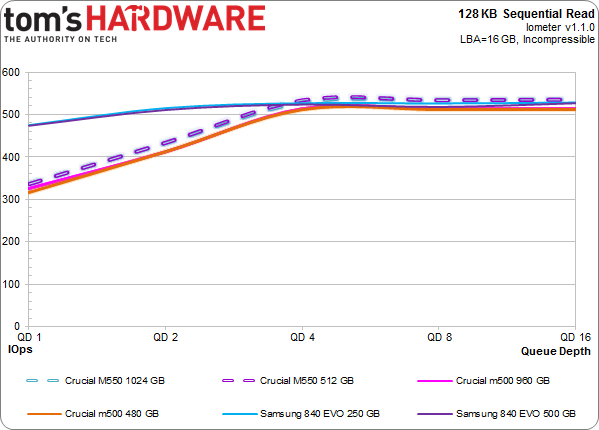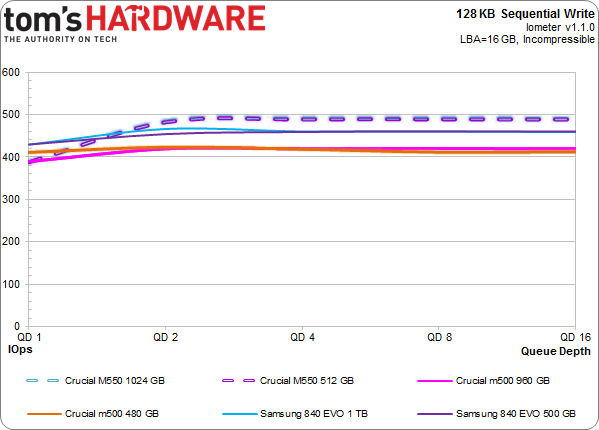The Crucial M550 SSD Review: Striking Back With More Performance
Crucial's M500 brought mainstream performance, enhanced features, and rock-bottom pricing together in one of the most-recommended SSDs of 2013. Following up, Crucial has a refined version called the M550, juiced-up for performance-hungry enthusiasts.
Results: Sequential Performance
Fantastic sequential read and write performance is a trademark of modern SSDs. To measure it, we use incompressible data over a 16 GB LBA space, and then test at queue depths from one to 16. We're reporting these numbers in binary (where 1 KB equals 1024) instead of decimal numbers (where 1 KB is 1000 bytes). When necessary, we're also limiting the scale of the chart to enhance readability.
128 KB Sequential Read
You may notice that out of the six SSDs shown (the two M550s, two M500s, and the 840 EVOs), only Samsung's 840 EVO models get anywhere near 500 MB/s at a queue depth of one. Small 128 KB requests aren't able to fully utilize Crucial's flash, I believe. This is actually fairly common behavior, and certainly not a result I'd call troubling. Had I tested 1 MB reads instead, performance at those low queue depths would increase.
The 512 and 1024 GB M550s eventually land in the lead, though all six SSDs are incredibly quick beyond a queue depth of two.
128 KB Sequential Write
With three 512 GB-class drives employing 32 dies and three 1 TB-class SSDs armed with 64, a lack of parallelism is not a problem. The M550s nevertheless stand on top of the competition at a queue depth of two, though, demonstrating writes very near 500 MB/s. Crucial's older M500s are nearly 100 MB/s behind, while Samsung's 840 EVOs split the difference.
Of course, I have to point out that the 840 EVOs use a caching mechanism that emulates the characteristics of SLC NAND, which dramatically affects this test's reported performance. Longer write workloads would exhaust even the 1 TB 840 EVO's 12 GB of emulated SLC memory. In contrast, the M550s don't have to use any special tricks to achieve their speed.
Get Tom's Hardware's best news and in-depth reviews, straight to your inbox.
Here's a breakdown of the maximum observed 128 KB sequential read and write performance with Iometer:
Sequential performance wasn't one of the M500's weaknesses. But an extra boost in this test is bound to enhance certain applications, especially when it comes to high-res video and RAID arrays. The speed-up pushes Crucial's new drives into seventh and eighth place, a move made more impressive by the fact that everything higher up the chart makes certain quantities of multi-level cell flash behave like single-level cell memory. That speed only lasts as long as the cache, though. Meanwhile, Crucial should be able to sustain its aggressive performance numbers.
Current page: Results: Sequential Performance
Prev Page Test Setup And Benchmarks Next Page Results: Random Performance

